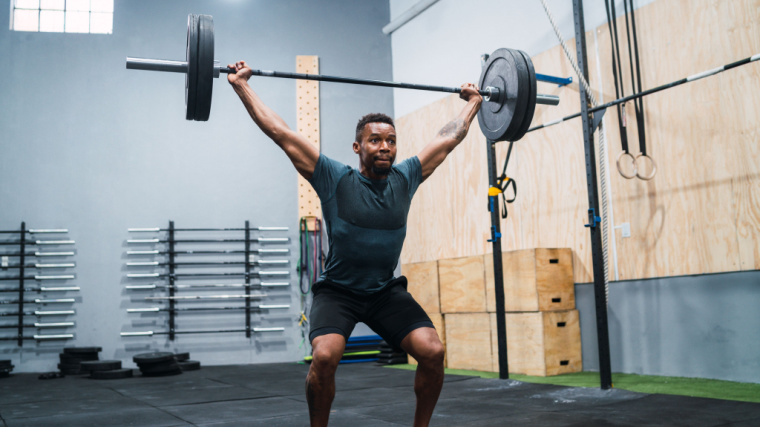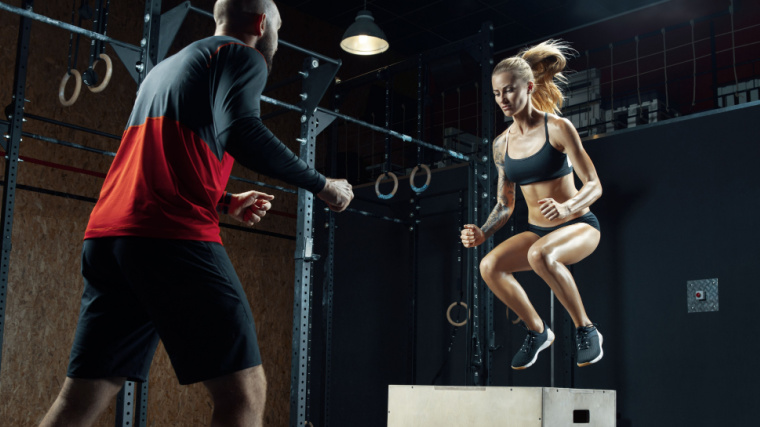If you’re new to CrossFit, you can make incredible progress by just showing up consistently each week. The variation in workouts and exposure to functional movements will provide a powerful stimulus, allowing you to get stronger and fitter with very little planning. Your main focus during this beginner period should be to learn the correct form for each movement and build a strong foundation.

Eventually, simply showing up to the gym will not be enough to continue making gains. You’ll need to take a more strategic approach to training in order to continue improving. Today, we’re going to review progressive overload — how to strategically make your CrossFit workouts more effective and break through plateaus — and the different methods you can apply to your day-to-day training.
- What is Progressive Overload?
- Methods of Progressive Overload
- Progressive Overload for CrossFit WODs
- Progressive Overload for CrossFit Conditioning
- Extra Credit and Skill Days
- Logging Workouts
What is Progressive Overload?
Progressive overload is the practice of making movements and workouts more challenging over time to continue growth and development. This intention and focus creates the distinction between training and merely exercising.
When you exercise, it’s great — but you don’t necessarily have a bigger plan. When you link your exercises into a program to train, you’re focused on tangible improvement towards a goal.
Progressive Overload in CrossFit
In the context of CrossFit training, the goal is developing well-rounded fitness — or, as some prefer, functional fitness or general physical preparedness. To achieve this broad range of fitness skills, CrossFit uses different modalities, such as weightlifting, gymnastics, and monostructural movements. These combine multiple functional movements into timed or AMRAP (as many rounds as possible) workouts.
This library of movements is mixed into different combinations of time frames, weights, equipment, and repetition schemes. CrossFit uses as much variety as possible to give you the broadest possible range of fitness. This means that, in any given CrossFit training program, there are many different ways to progressively overload toward improvement.
Different Starting Points
Each individual will start with a different baseline of fitness and athletic background. For example, some people have a background in or affinity for weightlifting, while others may be better suited for endurance training.
This is why there is not a cookie cutter model for progressive overload. Each person will have to apply the different methods of progressive overload to target their specific weaknesses and goals.
Methods of Progressive Overload
There are several methods of progressive overload that you can apply to strength training of any kind. The basic principle is about gradually increasing one factor at a time so that you’re making your training more challenging without doing too much too fast.
Some of these progressive overload methods are:
- Increasing Range of Motion
- Increasing Repetitions (volume)
- Increasing Weight
- Decreasing Rest Periods
- Increasing Density (doing the same work in less time)
- Increasing Frequency (doing the same load and volume more often)
Due to the varied nature of CrossFit, understanding these different methods will help you to modify each day of training to get the most out of your workout.
Progressive Overload for CrossFit WODs
In powerlifting programs, you know what lifts and weights you’re going to do every day in the weight room. It’s the same with weightlifting and bodybuilding programs — innovative and variable, but predictable.
CrossFit is anything but predictable, whereas progressive overload is strategically planned and gradually. But progressive overload can still be applied in CrossFit. Here’s how.
Increasing Range of Motion
The functional movements used in CrossFit are meant to be trained at a full range of motion. Limitations in your mobility will inhibit your ability to maintain good form, which can put you at a higher risk for injury.
On the other hand, pushing your mobility too hard too fast can also set you up for unintended failure. So if you want to get better at CrossFit, gradually increasing your range of motion is a great method of progressive overload.

Find a range of motion that allows you to maintain good form for a given movement. This should be comfortable and consistent for every repetition. Each subsequent workout that you perform the movement, try to slightly increase the range of motion while still maintaining good form. Let form guide the speed of your progression, only increasing the range as form allows. Over time, following this method you will be able to execute the movement at full range with no discomfort.
During this process, don’t increase your weight and reps. Instead, only focus on your range of motion. With each time you practice a movement — an overhead squat, for example — sink a little deeper into the squat.
Increasing Repetitions
Being able to perform more work is a key element of increasing overall fitness. A popular workout format is the AMRAP (as many reps or rounds as possible). These workouts prescribe a given amount of time to do as much work as possible of a given circuit.
A perfect example would be the workout Cindy, which is five pull-ups, 10 push-ups, and 15 air squats repeated for 20 minutes. If you were able to perform 15 rounds the first time you tested this workout, the goal would be to increase the total volume and beat your previous score. The key is to not change any other variable when progressively overloading with an increase in your repetitions.
For example, if you modified to band-assisted pull-ups and knee push-ups, you shouldn’t attempt to increase the difficulty of the movements while simultaneously trying to increase the repetitions from a previous score. Focus on increasing one thing at a time to see tangible progress. Only when you reach your repetition goal should you start thinking about progressing the movement difficulty.
Increasing Weight
Adding more weight is the most popular method of progressive overload for strength segments in CrossFit. Be sure to keep the rep count in mind when trying to increase weight from a previous session. For example, if you performed a heavy snatch for one rep in your last session, but today is calling for a heavy five reps, now is not the time to try and add weight.
Varied strength programming will require you to keep a record of your different lift weights in various rep ranges. If you’re increasing weight as your current method of progressive overload, strive to increase weight each time a rep range is repeated.
Decreasing Rest Periods
Gradually using shorter rest periods helps you boost muscle endurance development and increase conditioning.
For example, say you’re looking to improve your toes-to-bar stamina. You could start by performing 10 reps every 90 seconds for seven sets, totalling 70 reps overall. Repeat this workout each week while reducing 10 seconds from the rest interval each time. This would mean that within four weeks, you will be performing 10 toes-to-bar every 50 seconds. Although the total volume didn’t increase, your recovery and muscle endurance will have improved.
This method can also be applied to stand alone strength training and monostructural sessions (with multiple moves per session). Programming work and rest intervals allows you to manipulate the intensity of a session.
Increasing Density
Increasing density refers to the ability to perform the same amount of work in less time. This method is extremely popular in CrossFit, as most of the popular benchmark workouts are scored for time.
For example, the benchmark workout Fran is has you perform sets of thrusters and pull-ups in three sets of 21, 15, and 9 reps for time. As prescribed, men use a 95-pound barbell while women use a 65-pound barbell. (While CrossFit allows trans athletes to compete with other athletes from their own gender, there are no official load standards for nonbinary athletes.)
With benchmark workouts like this, the work and standards are assigned and you try to complete it as fast as possible. Periodically repeating benchmarks such as the one listed above is an important part of measuring your progress.
Increasing Frequency
It’s uncommon to repeat a movement within a week of training at a CrossFit box. This is often why it takes people so long to develop higher level skills.
Instead of increasing your workout frequency by adding more of the same WODs within a week, you can consider adding an extra skill day to increase exposure to certain movements you’re looking to improve.
Training for movement skills will help you increase your frequency without eating too much into your recovery. You’ll also improve your technique, positional strength, and muscle memory.
Progressive Overload for CrossFit Conditioning
Progressive overload is often applied to the strength training portion of CrossFit. But it’s often less clear on how to progress in conditioning workouts. Since workouts are not repeated on a consistent basis and movements may only be performed once every few weeks, how are you supposed to make progress with such irregularity of exposure?
The first step is understanding the different goals of each workout. Some of the questions to ask yourself — and your coach if you have one — include:
- What’s the time domain for the workout?
- Sprint (less than five minutes)
- Short (five to 10 minutes)
- Medium (10-20 minutes)
- Long (20+ minutes)
- If there’s a lifting movement, how should the weight feel?
- Light (low intensity)
- Moderately heavy (medium intensity)
- Very heavy (high intensity)
- If it’s a cardio movement, how long should the distance take to complete each round?
- How should movements be broken up each round?
- Perform each set unbroken
- Perform each set broken down into smaller sets
- How long should each full round take?
- If the workout is for time, how long should it take?
- If the workout is for reps, how many should you be able to complete in the allotted time?
If you’re taking a CrossFit class in an affiliate gym, your coach should review these points at the whiteboard brief when explaining the workout of the day. If any of these points aren’t addressed, be sure to ask questions so you can plan how to modify and attack the workout based on your needs and abilities.
Below, we’ll review three examples of assessing the goals of the workout and implementing progressive overload with popular CrossFit workouts. You can take the principles used here and apply them to other workouts on your own.
Helen
For this classic benchmark workout, you’ll perform:
3 rounds for time of:
- 400-meter run
- 21 kettlebell swings
- 12 pull-ups
Women: 35-pound kettlebell
Men: 53-pound kettlebell
As prescribed, the run should be fast, taking no longer than 3:00 each round. If that’s too fast for you, go at a pace that’s fast relative to your own ability level.
The kettlebell swings are supposed to feel light and should be performed unbroken — if needed, use a lighter weight than prescribed to make this possible.
The pull-ups shouldn’t be broken more than once per round. Use a resistance band to assist your reps if needed to make that possible, switching to inverted rows instead of pull-ups if necessary.
Say you’ve modified this workout to a 400-meter run, 21 kettlebell swings with a 26-pound kettlebell, and band-assisted pull-ups with a green band. The first time you performed the workout, you finished in 10 minutes, which is towards the faster end of performance for this workout.
Rather than keeping your modifications the same and trying to go faster, it may be appropriate to try the 35-pound kettlebell while keeping every other variable the same. If your time didn’t fall off dramatically, it may be appropriate to make the banded pull-ups more challenging the third time you repeat this workout. You can follow this pattern, using one of the methods of progressive overload each time you repeat the workout to continue improving.
If you can already perform this workout as prescribed, the way to progress will be to complete the work in less time and work towards executing the workout without breaking any of the movements.
DT
You’ll get used to some intense barbell moves during this WOD.
5 rounds for time of:
- 12 deadlifts
- 9 hang power cleans
- 6 shoulder-to-overheads
Women: 105-pound barbell
Men: 155-pound barbell
Regardless of what the prescribed weights are, opt to use a weight with which you can complete an unbroken round without putting the barbell down. Aim for each round to take between 1:15 to 2:30 minutes, with the full workout to be completed in the six to 12-minute range.
To progressively overload barbell-based workouts like this, simply find the weight that allows you to stay in alignment with the workout goals. If the workout took you over 12 minutes, stick with the same weight until your time is towards the faster end of the range. Once you’re able to complete the work in the appropriate range, make small increases to the weight on the barbell each time you repeat the workout.
Diane
This WOD combines barbell work with advanced calisthenics, so you’re going to have a mixed approach to progressive overload here.
21-15-9 reps for time of:
- Deadlifts
- Handstand Push-Ups
Women: 155-pound barbell
Men: 225-pound barbell
The aim here is to not break up your deadlifts more than twice per round. Modify the handstand push-ups so that you can complete the round of 21 reps with no more than two breaks. Since the rounds are descending in reps, there won’t be a consistent round pace. The full workout should take between three and nine minutes.
Say you have no problem with the deadlifts but can’t yet perform handstand push-ups. Keep the deadlifts as prescribed at 225 pounds and modify the handstand push-ups to pike push-ups in order to finish within the goal time range.
If you’re able to accomplish this, you may progress the difficulty of the handstand push-ups by performing handstand push-ups with your feet on a plyo box. As time goes on, you can try handstand push-ups with decreased reps until you’ve worked your way up to performing the workout as prescribed.
Extra Credit and Skill Days
Consistently attending a CrossFit class four to six times per week will help you get stronger and fitter, but there may come a time in your development where specific training is what you need to keep getting better. Sometimes, a varied program will not allow you to work on specific movements consistently enough to master technique.
This is most common with higher skill movements like weightlifting or gymnastics exercises. Movement mastery requires practice, which is best achieved with lots of repetition at a low heart rate. You can do this without adding full-out, sweat-inducing training sessions to your week.

If your schedule allows for it, try adding 10 minutes of “extra credit” skills work after class, two to three times per week. This will allow you to keep your regular training schedule and accumulate 20 to 30 minutes of extra skill development per week.
It may also be helpful to substitute one of your regular training days with a skill day. This is where you’d replace a regular WOD with an hour of drills and progressions targeting the skill you’re trying to develop.
Logging Workouts
Since workouts and movements are not repeated on a weekly schedule in CrossFit, tracking results will become even more important for future reference.
Keeping a training log in CrossFit is important for several reasons. It will help you have an objective view of your current ability, which will allow you to set realistic goals for short and long-term training. As time goes on, you’ll be able to recognize patterns and make adjustments so that you begin training smarter, not just harder.
A training log will also help you recognize that progress — perhaps especially in CrossFit — isn’t linear. You’re going to have ups and downs as you train over a long period of time. Tracking will allow you to be less emotionally attached to your day-to-day results and help you have perspective for the big picture.
When logging your workouts, it’s important to track as many metrics as possible to provide context for future workouts. Some of these include:
- Movement(s) performed
- Weight(s) lifted
- Total repetitions completed
- Time to complete workout
- Additional notes on how the weights felt, your mood, recovery, sleep, nutrition, etc.
There’s no shortage of applications and software to make tracking lifts and workouts convenient and easy. Many CrossFit gyms will have a performance tracking software as part of their membership, but simply writing things down via pen and paper is a great option, as well.
Regardless of how you choose to log your training, be sure to record day-to-day training and reference past performance. This will help you strategize and implement methods of progressive overload for upcoming workouts and training cycles.
Consistency is Key
Even with a strategy, things will not always go according to plan. Real life will get in the way of your training now and again. You may have to use the principles of progressive overload to modify the day’s training based on how things are feeling on that specific day.
That’s okay — progress will never be linear. Be patient and keep training hard, using the methods of progressive overload to break through plateaus as they come. The most important factor above all is consistency — so learn to love the process and keep showing up.
Featured Image: Mix Tape / Shutterstock